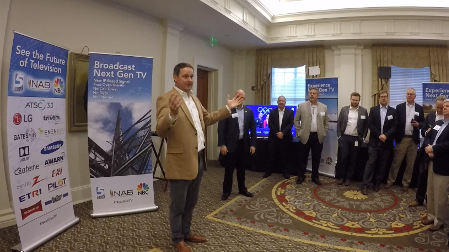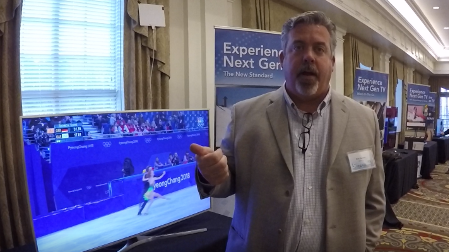RALEIGH-DURHAM, N.C.—WRAL-TV, with the help of NBCU and NAB, put on quite a display of Next-Gen TV last night at the State Club near the station’s studios.
Ostensibly, the reason for the gathering was to view NBCU’s 4K UHD HDR coverage of the Winter Olympics from PyeongChang, South Korea, being transmitted over-the-air by WRAL on Channel 39.

Jim Goodmon Jr. presenting during Next Gen TV Monday in Raleigh, N.C.
But there was far more to this event than a demo of Ultra HD. This was a public showing of a complete ATSC 3.0 ecosystem that is as well suited to delivering 4K HDR as it is to serving up mobile television, interactivity and advanced emergency alerts. In other words, next-generation TV today is delivering on its many promises—not simply in South Korea where it has been deployed to deliver that nation’s coverage of the Winter Olympics over the air in 4K, but also here in the United States.
“I think what you are seeing… is the standard has now been completed,” said NAB CTO Sam Matheny during an interview in the hallway outside the event. “It [ATSC 3.0] was finished in January. Here we are in February broadcasting the world’s largest sporting event in a demonstration like we have tonight.”
Inside, WRAL Director of Engineering and Operations Pete Sockett walked the roughly 75 people in attendance for the VIP Next Gen TV event through the demonstration. WRAL broadcasts ATSC 3.0 to Raleigh from an elliptically polarized antenna affixed 1,740 feet in the air on one of its towers in a nearby rural community, according to Sockett.
“It’s a 40kW transmitter that’s covering all of Raleigh,” he explained. “To put that into perspective, this signal is 40kW; WRAL’s main signal is a million [watts ERP].”
The professional video industry's #1 source for news, trends and product and tech information. Sign up below.
MORE POWERFUL & EFFICIENT
ATSC 3.0’s OFDM modulation scheme is so much easier to receive than ATSC 1’s 8VSB –even at the comparatively low power WRAL is using—that the new standard will make it possible for broadcasters to reach viewers over-the-air using smaller home antennas, on the road and even in their basements, he said.
[Next-Gen TV Using Olympic Stage as Showcase]
On two tables arranged side-by-side, the demo illustrated how the standard enables different physical layer pipes (PLPs), to deliver a high data rate bitstream to a Samsung 4K UHD HDR television using a simple Mohu Leaf antenna and a much lower data rate bitstream to deliver a highly robust 1080p signal to ordinary media tablets equipped with a Next Gen TV dongle and antenna from South Korea’s ETRI electronics institute.
“This is PLP 1, which is the enhancement layer of LDM [at] 19.5Mbps HEVC,” said Sockett during a one-on-one interview as he pointed to the Samsung UHD television. “PLP 0 [which was being received by the dongle-enabled tablets] is a robust, lower data rate [of] 4.5Mbps throughput, which is running our regular WRAL [content] HEVC encoded [and] AAC audio,” he said.
Sockett added that he has received a robust mobile signal with a tablet outfitted with a dongle supplied by ETRI (a South Korean government tech research group) at 70mph as he has driven home from the station. Jim Goodmon Sr., CEO and chairman of the board of Capitol Broadcasting Company, interjected at the conclusion of Sockett’s presentation that ATSC 3.0’s robust signal will one day put over-the-air television on mobile phones.
Recounting the failure of Mobile DTV, Goodmon reminded the room that the first go broadcasters had at delivering TV to mobile devices depended upon a separate signal, not the core ATSC 1.0 transmission, because the main signal was not sufficiently robust to be received by cell phones and other mobile platforms.
“We came up with a new plan and created another signal, and guess what the networks said,” recalled Goodmon. ‘The networks said, ‘Guys, that’s another TV station. You can’t put our stuff on that mobile signal.’”
However, with ATSC 3.0, the same type of decoder chip used in a television will be available to cell phone makers to receive the same Next-Gen TV signal, he noted. Jimmy Goodmon Jr., president and COO of Capitol Broadcasting Company, reiterated his father’s comments in an interview outside the event.
“It [the separate A/53 and A/153 signals] created a complicated, a bit convoluted, unknown ecosystem,” he said. “Mobile DTV didn’t take off because we couldn’t get the content. If we would have gotten the content out there, the chip makers would have made the chips, and I think people would have put the chips in the phones.”
The tablet portion of the demo also featured an ATSC 3.0 gateway taking in the off-air signal from a Mohu Leaf antenna and retransmitting it as a Wi-Fi signal to an ordinary media tablet.
AWARN ENABLED
Elsewhere in the room, the latest developments in advanced emergency warning (AWARN) enabled by ATSC 3.0 were on display. Created by NAB and LG for the demonstration, the setup illustrated how AWARN could be used to better inform the public in an emergency through the use of rich media informing viewers what to do and where to avoid.
“We can send all of this information [over the air]. None of this needs the internet,” said Sockett, who also pointed out how much more flexibility the new system offers over existing EAS. “Say there is a missile warning and you want to stop the missile warning—we can actually stop it,” Sockett said, referring to the recent missile false alert in Hawaii.

Pete Sockett, and the rest of the event, highlighted some of ATSC 3.0's capabilities in relation to NBC Olympics' broadcast.
At the ATSC 3.0 interactivity demo, So Vang, vice president of advanced technology for NAB, showed off the latest interface his tech team has created to give users access to Next-Gen TV’s hybrid broadband-broadcast interactivity. In keeping with the evening’s Winter Olympics focus, Vang presented an on-screen tote board used to track the medal count of nations and individual athletes that pulled data from the internet. He also showed the Next-Gen TV connected to an ATSC 3.0 gateway retrieving WRAL weathercasts from the internet, on-demand WRAL content, a WRAL-specific electronic program guide and a user account screen that allows individuals to set up their unique preferences.
[ATSC 3.0 Rollout Can Begin Next Month]
Rounding out the demo area was an ATSC 3.0 signal analysis ecosystem with equipment from a variety of companies including DekTec, Triveni and Rohde & Schwarz. “When we first started this a year and a half ago… there was a lot of guessing going on,” said Sockett. “Well this community is growing up as well, and it’s really made a difference.”
ATSC 3.0 transmission isn’t limited to Raleigh and South Korea, however. Sinclair Broadcast Group has been testing SFN transmission in the Baltimore-Washington corridor and has announced plans to do a full SFN test rollout in Dallas. NAB and CTA are on-air from a Tribune station in Cleveland; and the Pearl TV consortium is setting up a model ATSC 3.0 market in Phoenix.
“There are other stations we have talked to that have intentions of going on the air [with ATSC 3.0],” said NAB’s Matheny. “So, what I think you are starting to see is people saying, ‘OK, the standard is done. What can we do to begin deploying it?’”
For a comprehensive list of TV Technology’s ATSC 3.0 coverage, see our ATSC3 silo.
Phil Kurz is a contributing editor to TV Tech. He has written about TV and video technology for more than 30 years and served as editor of three leading industry magazines. He earned a Bachelor of Journalism and a Master’s Degree in Journalism from the University of Missouri-Columbia School of Journalism.

